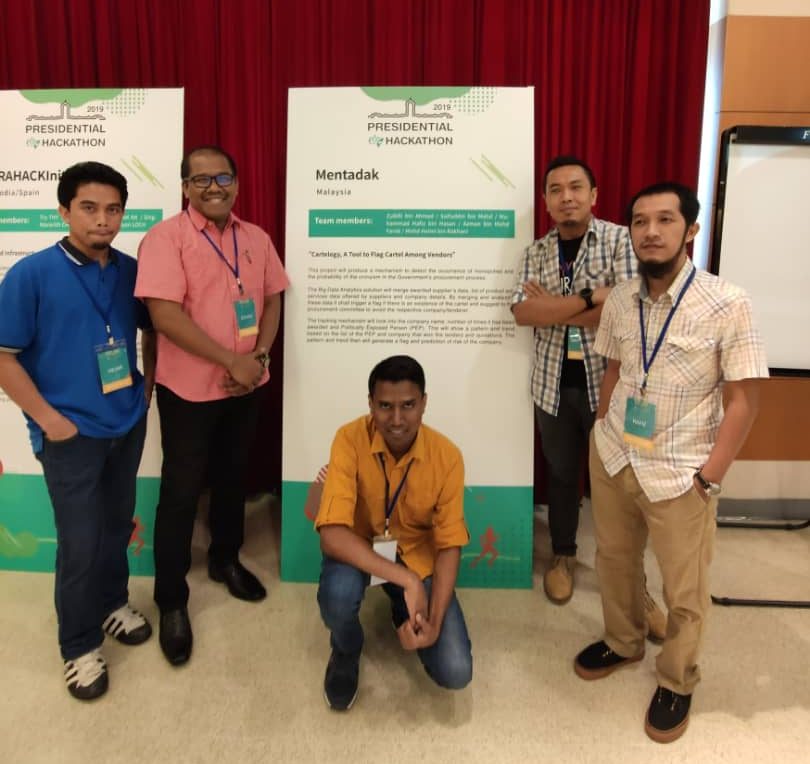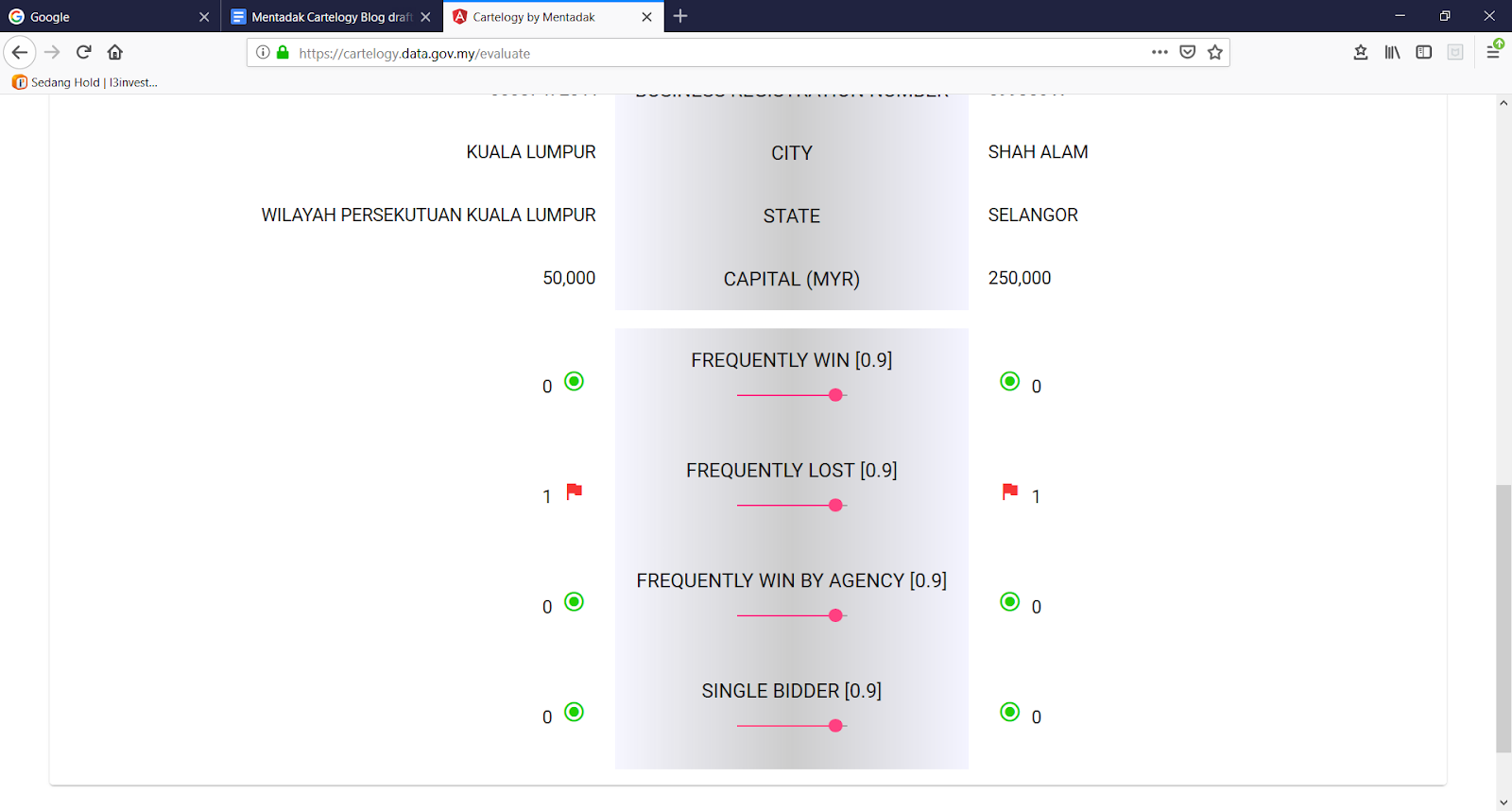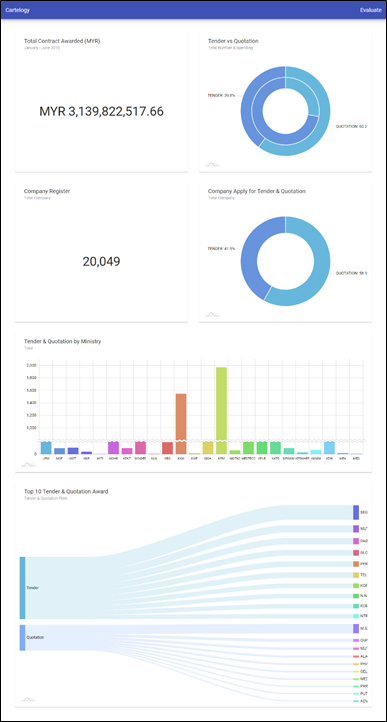Cartelogy: A tool for fair competition and corruption-free public procurement in Malaysia

OCP recently worked with the Presidency of Taiwan to hold an international hackathon, inviting participants from around the world to propose solutions for building better and sustainable infrastructure, using open data. The event was a huge success, and we were very impressed with the smart and innovative work produced by all participants. We’re proud to feature the top teams’ projects in this blog series.
The Malaysian government spends about RM220 billion (US$55 billion) a year on public procurement for development and assets. However, public procurement is one of the government activities that is most vulnerable to corruption. According to the Malaysian Anti-Corruption Commission (MACC), out of the 10 sectors most prone to corruption in Malaysia, the highest number of complaints received between 2013 and 2018 was in public procurement. The National Anti-Corruption Plan 2019-2023 (NACP) also listed political governance, public sector administration, and public procurement in the top six corruption risk areas. For every dollar spent on public procurement globally, 20 to 30 cents is lost due to corruption, according to an estimate by the World Bank.
 This is why my colleagues and I from the Malaysian Administrative and Modernisation Unit (MAMPU), an agency within the Prime Minister’s Department (PMD) formed our Team – Mentadak. We wanted to develop Cartelogy, a proactive and preventative tool to help the Ministry of Finance and other procurement agencies identify potential bid-rigging and corruption risks in public procurement, specifically at the tender stages before contracts are even awarded.
This is why my colleagues and I from the Malaysian Administrative and Modernisation Unit (MAMPU), an agency within the Prime Minister’s Department (PMD) formed our Team – Mentadak. We wanted to develop Cartelogy, a proactive and preventative tool to help the Ministry of Finance and other procurement agencies identify potential bid-rigging and corruption risks in public procurement, specifically at the tender stages before contracts are even awarded.
Cartelogy joins up procurement data, company profile data and political persons data to create a “red flag” mechanism/tool to analyse, evaluate, and detect potentially suspicious activities from the outset so that respective decision makers (as well as oversight committees and relevant authorities) will be better equipped to make informed procurement evaluation and contract award decisions (see system architecture below). This will reduce the probability of contracts being awarded to ‘phantom’, ‘crony’ or colluding companies and expose conflicts of interests or personal relationships between public officials and companies. Thus levelling the playing field and creating fairer competition. Companies winning contracts are more likely to be able to fulfil their contractual obligations to deliver the goods, services or works to the quality or standards expected at a reasonable price.

In this working prototype, Cartelogy will produce Open Contracting Data Standard (OCDS) data from the various data sources. OCDS is especially important for opening up all phases of the planning, tendering and contracting process, and will help connect complex datasets from multiple sources to deliver useful and incisive analysis, which the government can use to reform public procurement processes and practices so that it is more efficient and effective. It also offers an opportunity for the government to resolve data interoperability issues in their data sharing initiatives.
As part of this work, we successfully converted almost 7,000 contracts into the OCDS format. We also built an interactive test website that is free to use, and once fully operational, would allow anyone to run searches on companies or contracts to check for ‘red flags’. In the future, we hope that the OCDS will be fully integrated into ‘e-perolehan’, the Ministry of Finance e-procurement system so that it can automatically feed into the Cartelogy application from the start. This will make the tool much more efficient and enable greater scale and scope.
We presented our prototype at the Taiwan Presidential Hackathon in July and were thrilled to place in the top 2 teams out of almost 30 applicants! We learnt a lot from the other competing teams as well as the open contracting mentors and technical experts.
The results we gathered from the prototype are encouraging. We were able to validate our rules and red flags (that is, we confirmed they worked!) by comparing them against the findings of the first bid-rigging case in Malaysia. In this scenario, we analysed two out of the eight companies which were fined for bid-rigging on March 4, 2019. The validated result was a major breakthrough of our prototype.
Test site visualisations:
Now that we have a proof of concept, we intend to continue developing this prototype so that it can be fully integrated into our federal procurement systems. We will begin talks with the Ministry of Finance on how to integrate Cartelogy into e-perolehan, the national procurement system. We also intend to present this tool to a Cabinet Special Committee on Anti-Corruption, which is chaired by our prime minister, in an effort to ensure high-level visibility and strong mandate for our tool.
Although this project was developed by focusing on public procurement practices at the federal level in Malaysia, it is also relevant and applicable to the state and local levels, as well as to other government-linked companies (GLC) – which are historically exempt from many procurement laws and regulations, and statutory boards – and others that are affected by this type of corruption risk in their procurement processes.
Beyond improving competition and fighting corruption at home, our broader aspirational goals are for Cartelogy to contribute best practice and lessons that can be shared across Southeast Asia, and over time, help to create a new norm for better governance, especially in public procurement in the region, which has to date, been relatively poor.
The Cartelogy prototype is only the start of an important journey; its success in achieving our ambitious goals will require full support from the Government to further enhance and fully adopt the application, and in tandem, the collaboration of NGOs, industry and academia so that we can work together to improve public goods, services and works and ensure all Malaysians benefit.


